|
|
|
Sort Order |
|
|
|
Items / Page
|
|
|
|
|
|
|
| Srl | Item |
| 1 |
ID:
153713
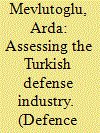

|
|
|
|
|
| Summary/Abstract |
The reform process of Turkish defense industry as launched in the last quarter of the twentieth century has seen several achievements, as well as downfalls, and passed through major milestones. The resultant industrial structure is unique, compared to the other sectors in the country. Dominated by the TSKGV (Turkish Armed Forces Foundation), the major goal of the sector has always been involved in attaining self-sufficiency, indicative of an import substitution-oriented industry policy. This strategy is evident in decision-making and execution processes of virtually all defense procurement programs. However, lack of an efficient mechanism for science and technology policy-making mechanism, is observed as a major obstacle toward sustainable development of the sector. Although benefited from the overall economic take-off during the 2000s, today the Turkish defense industry faces to the challenge of sustainability, which is heavily dependent on export performance. The forthcoming period will test the sector, revealing the necessary coordination and communication by and between the military and civilian bureaucracies.
|
|
|
|
|
|
|
|
|
|
|
|
|
|
|
|
| 2 |
ID:
124772


|
|
|
|
|
| Publication |
2013.
|
| Summary/Abstract |
Technological ties between Israel and China have always been a central and constant element of their relationship. Defense contracts played a leading role here but were also responsible for the severe crisis that erupted between the countries in the early 2000s after Israel, capitulating to US pressure, backed off from its commitment to provide China with military technologies. This not only forced Israel to sever its defense relations with China but also made US-Israel relations a principal factor in the Sino-Israeli connection and imposed tight constraints on Israel's technology transfers to China generally. For Israel, this placed the dilemma of commercial versus political and national security interests at the forefront, since technology connections allowed it to promote its economic, political, and strategic causes through China. Indeed, while technology ties between the states have not stopped entirely-they have shifted to the civilian sphere-technology transfers to China are subject to heavy limitations, and Israel's export control mechanism faces greater challenges to screen them. As China's economic and political influence is ever increasing, Israel's cautious approach to technology transfers to China may be expected to come under mounting pressure.
|
|
|
|
|
|
|
|
|
|
|
|
|
|
|
|
| 3 |
ID:
126461


|
|
|
|
|
| Publication |
2012.
|
| Summary/Abstract |
Over the last six years Clarion Events has built up Defence & Security Equipment International (DSEI) to become the world's largest fully integrated defence and security exhibition. Over that period, global spend on defence and security has fluctuated; however, nations such as India have found themselves on the positive side of this change. With the Indian aerospace defence industry being one of the fastest growing in the world, this has attracted major global aerospace companies to India and the reason why events like DSEI have become so important, as companies around the world adapt to the changing environment and look towards new markets to trade and build business ties.
|
|
|
|
|
|
|
|
|
|
|
|
|
|
|
|
| 4 |
ID:
140550
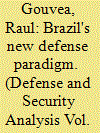

|
|
|
|
|
| Summary/Abstract |
In 2015, Brazil has taken steps toward re-consolidating its domestic defense industry. In the 1980s, Brazil built a dynamic and diversified defense industry. The state-driven effort resulted in a tripod strategy, where the state, state-run companies, and their private sector became the pillars of Brazil's defense industry. Brazil developed an export-driven defense industry; where close to 80–90% of its output was exported to Latin American, African, Arab, and Asian nations. In the 1980s, Brazil became the world's fifth largest exporter of defense products and services, exporting to over 40 countries. In the 1990s and 2000s, Brazil's defense industry suffered a dramatic reduction in size, diversification, and momentum. Successions of domestic political and economic policies have relegated Brazil's once emerging defense industry to a marginal position in the global defense industry. This article analyzes future prospects, challenges, and growth strategies for Brazil's defense industry.
|
|
|
|
|
|
|
|
|
|
|
|
|
|
|
|
| 5 |
ID:
173121


|
|
|
|
|
| Summary/Abstract |
Drawing upon 106,181 patent applications by the world’s largest defense firms and 241,571 patent citations (2002–2011), this article has two main objectives. The first is to explore the factors affecting the production of mixed patents (those with potential dual applications in both military and civilian spheres). The second is to identify the causes of the use of military knowledge for civilian inventions (spin-off) and the use of civilian knowledge in military patented technologies (spin-in). Our calculations show highly significant coefficients for the variables capturing the “military technological capability” and the size of the company in explaining the production of mixed technologies. The spin-off process is affected by the military technological capability, the size of the firm, and the location. The spin-in mechanism is explained by the military technological capability and the location of the firm, while the size of the company is not relevant.
|
|
|
|
|
|
|
|
|
|
|
|
|
|
|
|
| 6 |
ID:
182633
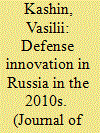

|
|
|
|
|
| Summary/Abstract |
The chapter examines the driving forces and the institutions behind the Russian military buildup in the period between 2010 and 2020. The beginning of the rapid Russian military modernization in late 2000s was the result of the shifting threat assesments by the Russian political leadership and the painful lessons of the war with Georgia in 2008. Russia had to conduct an throughout and painful restructuring of the military institutions and the defense industrial complex in order to be able to meet the ambitious goals of its’ rearmament program. The result was significant growth in the Russian military capabilities by the middle of the decade.
|
|
|
|
|
|
|
|
|
|
|
|
|
|
|
|
| 7 |
ID:
155830
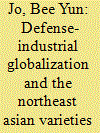

|
|
|
|
|
| Summary/Abstract |
In observation of the first US multilateral collaborative program in advanced fighter-jet production, the F-35 JSF, I analyze the implications of the so-called defense-industrial globalization phenomenon for the Northeast Asian region by examining the fighter-jet acquisition patterns of South Korea, Japan, and Taiwan. I explore the applicability of the Varieties of Defense-Industrial Capitalism (VoDC) model, put forth by Marc R. Devore, which places emphasis on endogenous-institutionalist factors in projecting the adaptation patterns of states to defense-industrial globalization. By revealing theoretical and empirical limitations of the VoDC model when applied to Northeast Asia's fighter-jet industry, I argue that the Northeast Asian varieties of paths are a complex outcome of not only their endogenous settings but also US exogenous influence on the region. I also show that Devore's institutionalist and liberalist thesis on defense-industrial globalization does not hold for the cutting-edge fighter-jet industry where the first-tier states continue to be restrictive in their technology transfers, influencing the fighter-jet acquisition patterns of the three Northeast Asian states.
|
|
|
|
|
|
|
|
|
|
|
|
|
|
|
|
| 8 |
ID:
078235


|
|
|
|
|
| Publication |
2007.
|
| Summary/Abstract |
This paper explores whether defense contractors' manufacturing technology advantages over purely commercial firms might be associated with differences in their workforce and organizational practices. It uses unique original data collected specifically to test workforce and organizational complementarities in implementation of advanced manufacturing technology in small manufacturers. Findings are that defense contractors: (1) have higher and deeper rates of advanced manufacturing technology use; (2) have greater perceived success in achieving manufacturing goals; (3) are more likely practitioners across a diverse spectrum of advanced workforce and organizational practices. Then, (4) econometrically, the defense contractors' higher reported levels of achievement in implementing advanced manufacturing technologies are positively associated with those organizational and workforce practice differences
|
|
|
|
|
|
|
|
|
|
|
|
|
|
|
|
| 9 |
ID:
129371
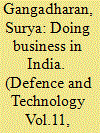

|
|
|
|
|
| Publication |
2012.
|
| Summary/Abstract |
For a company that made its India debut way back in 1954, Sikorsky may not inspire the same recognition level as other American or European contemporaries. In fact, it current presence in India dates back only four years.
|
|
|
|
|
|
|
|
|
|
|
|
|
|
|
|
| 10 |
ID:
086248
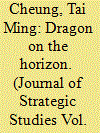

|
|
|
|
|
| Publication |
2009.
|
| Summary/Abstract |
China's grand ambition is to become a world-class military industrial power by 2020, but can it succeed? A concerted restructuring of the defense industry is taking place to tackle deep-seated obstacles constraining its ability to absorb, create and diffuse technological innovation. This includes promoting competition and creativity by reducing the reach of the state and encouraging enterprises to play a leading role, developing a robust regulatory and standards regime to provide benchmarks and rules, and forging integration between the civilian and military portions of the economy through spin-ons.
|
|
|
|
|
|
|
|
|
|
|
|
|
|
|
|
| 11 |
ID:
128838
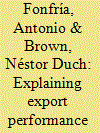

|
|
|
|
|
| Publication |
2014.
|
| Summary/Abstract |
This paper presents empirical results on the export performance of Spanish defense contractors. The objective is threefold. First, we briefly describe the export profile of the Spanish defense industry at the firm level. Second, in light of some results on the determinants of firm-level export intensity, we empirically test some of these variables for the case of defense-related exports. We find that exporters tend to be capital intensive, diversified, and showing high R&D effort. In the analysis by sectors, learning by exporting is the most frequent result. Third, we assess the exporter productivity premium, regressing productivity on exporter status and firm size. Our results indicate that when controlling for firm heterogeneity, no such premium exists.
|
|
|
|
|
|
|
|
|
|
|
|
|
|
|
|
| 12 |
ID:
192492
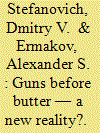

|
|
|
|
|
| Summary/Abstract |
Warfighting in Ukraine in 2022-2023 has become the first large-scale armed
conflict in Europe in the 21st century that directly involves Russia and
NATO. The scale of events, the geography of operations, the number of
weapons used and the personnel engaged require a reassessment of military
development and defense spending priorities in many countries around the
world. This article analyzes certain features of the current armed conflict
and the decisions already made by individual countries. The authors come
to the conclusion that given the scale of military buildup in Europe and
elsewhere it is advisable to think about new measures to reduce risks now
and establish effective arms control in the future.
|
|
|
|
|
|
|
|
|
|
|
|
|
|
|
|
| 13 |
ID:
192533


|
|
|
|
|
| Summary/Abstract |
Major arms producing states and defense firms have struggled to supply the Ukraine war's massive demand for munitions. Key elements of the war—such as artificial intelligence-enabled analysis of data obtained from commercial surveillance satellites transmitted by the privately-owned Starlink network—have emerged from new providers as well as developed organically on the battlefield. Research failed to anticipate this due largely to the discipline’s focus on the “defense industry” rather than three distinct “defense industries” highlighted in the war: platforms such as tanks, commodities such as artillery shells and loitering munitions, and militarized “tech” such as commercial satellites and artificial intelligence. Understanding each requires a distinct political economic approach. Using these three lenses, the article concludes that the United States retains advantages in all three industries, Europe risks regressing into a commodities producer, and China seeks to disrupt, rather than duplicate, American defense industrial advantages in technology.
|
|
|
|
|
|
|
|
|
|
|
|
|
|
|
|
| 14 |
ID:
148218
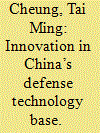

|
|
|
|
|
| Summary/Abstract |
China’s defense science, technology, and industrial system has been undergoing a far-reaching transformation over the past two decades and the single biggest factor behind this turnaround is the role of external technology and knowledge transfers and the defense industry’s improving ability to absorb these inputs and convert into localized output. China is pursuing an intensive campaign to obtain defense and dual-use civil–military foreign technology transfers using a wide variety of means, which is explored in this article.
|
|
|
|
|
|
|
|
|
|
|
|
|
|
|
|
| 15 |
ID:
125966
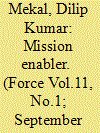

|
|
|
|
|
| Publication |
2013.
|
| Summary/Abstract |
An exclusive invitation to visit the Lincoln facility of UK-based Selex ES, for an in-depth experience at their Electronic Warfare Operational Support (EWOS) offerings, provided an excellent opportunity to get a closer look at EWOS and the crucial role it plays in today's battlefield. Over a packed day full of briefings on EWOS, this correspondent was taken through the entire spectrum of EWOS, starting from the various products and tools used to analysis and testing of the mission data file using hardware-in-the-loop simulators.
|
|
|
|
|
|
|
|
|
|
|
|
|
|
|
|
| 16 |
ID:
147494
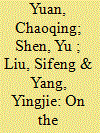

|
|
|
|
|
| Summary/Abstract |
As the most knowledge-intensive industrial sectors, China’s defense industries are developing very fast. The present paper will explore the contribution of China’s defense innovation to its economic growth. Cobb–Douglas production function, integrating defense and non-defense stock in knowledge, is applied during the course. In addition, an input–output analysis of defense equipment procurement was done. Positive effect of China’s defense innovation on economic growth has been revealed by comparing the results from the two methods. And some suggestions are made to strengthen the effect.
|
|
|
|
|
|
|
|
|
|
|
|
|
|
|
|
| 17 |
ID:
123210


|
|
|
| 18 |
ID:
153751


|
|
|
|
|
| Summary/Abstract |
The paper analyzes the foreign practice of CALS (Continuous Acquisition and Lifecycle Support) contracts. It offers a conceptual model of controlling the life cycle of products, which is to include the professional training of communication combat unit personnel of Navy surface ships (SS). It recommends creating a virtual learning environment for Navy specialists when taking up end-to-end lifecycle contracts. The authors conclude that these measures are necessary.
|
|
|
|
|
|
|
|
|
|
|
|
|
|
|
|
| 19 |
ID:
115266


|
|
|
|
|
| Publication |
2012.
|
| Summary/Abstract |
Scholars of corporate social responsibility (CSR), which refers to the responsibilities of a firm to society in four domains: economic, legal, ethical, and discretionary, have typically excluded defense firms from their research, mainly on ideological grounds. This study challenges these assumptions and measures the CSR orientations of managers of defense firms. The findings reveal the orientations of defense firm managers to be consistent with those of other corporate populations, though the highly regulated environment of defense contracting causes some differences. The findings help to redeem the social standing of defense firms, and by implication, their employees and the military members who use their products, from unwarranted antimilitary biases.
|
|
|
|
|
|
|
|
|
|
|
|
|
|
|
|
| 20 |
ID:
124701
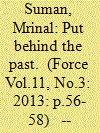

|
|
|
|
|
| Publication |
2013.
|
| Summary/Abstract |
On 18 September 2013, during his visit to India, US deputy secretary of defence Ashton B. Carter, the second highest ranking official of the Pentagon, made a momentous offer of technological cooperation to India. More significantly, he announced that the US was prepared to co-develop and co-manufacture products that could be sold internationally. It was a major policy statement that reflected a keen desire of the US to improve military ties with India. The offer took many Indian observers by surprise.
During the Cold War period, Indo-US military relations were either non-existent or lacked intensity. The US considered India to be in the Soviet camp and declined to sell any worthwhile military equipment to it. The collapse of the Soviet Union saw the end of the Cold War. Thereafter, protracted Indo-US engagement resulted in the 'Agreement on Defence Relations' in 1995.
|
|
|
|
|
|
|
|
|
|
|
|
|
|
|
|
|
|
|
|
|